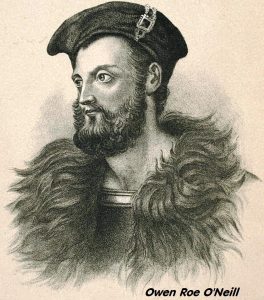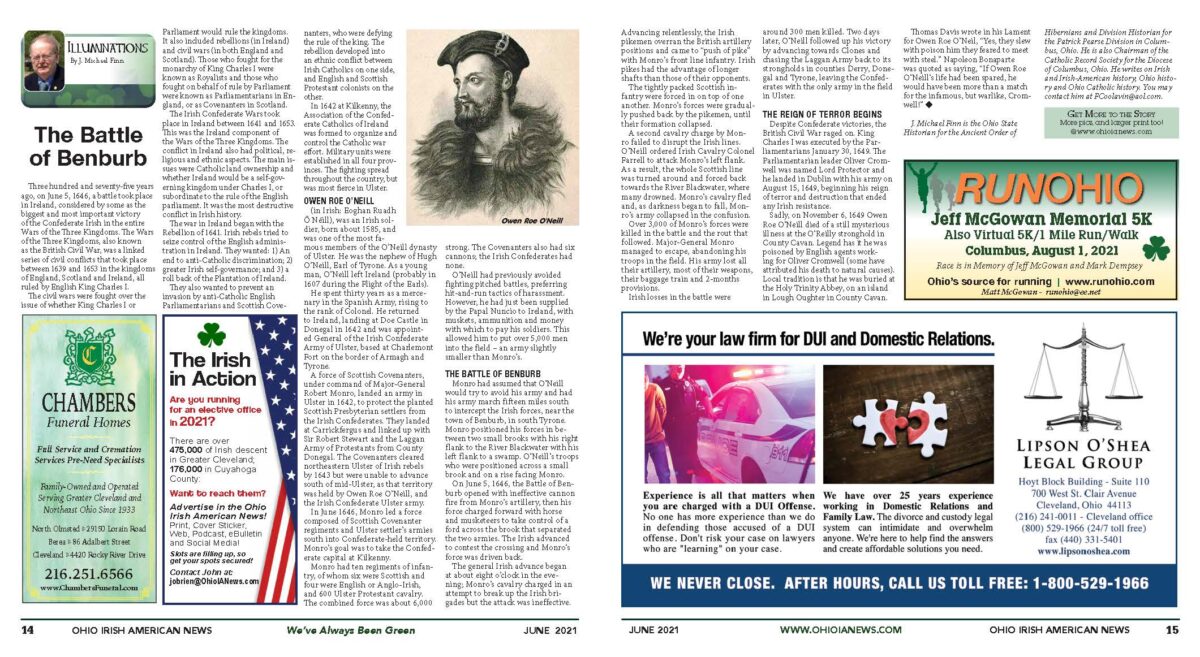

Illuminations: The Battle of Benburb
By: J. Michael Finn
Three hundred and seventy-five years ago, on June 5, 1646, a battle took place in Ireland, considered by some as the biggest and most important victory of the Confederate Irish in the entire Wars of the Three Kingdoms. The Wars of the Three Kingdoms, also known as the British Civil War, was a linked series of civil conflicts that took place between 1639 and 1653 in the kingdoms of England, Scotland and Ireland, all ruled by English King Charles I.
The civil wars were fought over the issue of whether King Charles I or Parliament would rule the kingdoms. It also included rebellions (in Ireland) and civil wars (in both England and Scotland). Those who fought for the monarchy of King Charles I were known as Royalists and those who fought on behalf of rule by Parliament were known as Parliamentarians in England, or as Covenanters in Scotland.
The Irish Confederate Wars took place in Ireland between 1641 and 1653. This was the Ireland component of the Wars of the Three Kingdoms. The conflict in Ireland also had political, religious and ethnic aspects. The main issues were Catholic land ownership and whether Ireland would be a self-governing kingdom under Charles I, or subordinate to the rule of the English parliament. It was the most destructive conflict in Irish history.
The war in Ireland began with the Rebellion of 1641. Irish rebels tried to seize control of the English administration in Ireland. They wanted: 1) An end to anti-Catholic discrimination; 2) greater Irish self-governance; and 3) a roll back of the Plantation of Ireland.
They also wanted to prevent an invasion by anti-Catholic English Parliamentarians and Scottish Covenanters, who were defying the rule of the king. The rebellion developed into an ethnic conflict between Irish Catholics on one side, and English and Scottish Protestant colonists on the other.
In 1642 at Kilkenny, the Association of the Confederate Catholics of Ireland was formed to organize and control the Catholic war effort. Military units were established in all four provinces. The fighting spread throughout the country, but was most fierce in Ulster.
Owen Roe O’Neill
(in Irish: Eoghan Ruadh Ó Néill), was an Irish soldier, born about 1585, and was one of the most famous members of the O’Neill dynasty of Ulster. He was the nephew of Hugh O’Neill, Earl of  Tyrone. As a young man, O’Neill left Ireland (probably in 1607 during the Flight of the Earls).
Tyrone. As a young man, O’Neill left Ireland (probably in 1607 during the Flight of the Earls).
He spent thirty years as a mercenary in the Spanish Army, rising to the rank of Colonel. He returned to Ireland, landing at Doe Castle in Donegal in 1642 and was appointed General of the Irish Confederate Army of Ulster, based at Charlemont Fort on the border of Armagh and Tyrone.
A force of Scottish Covenanters, under command of Major-General Robert Monro, landed an army in Ulster in 1642, to protect the planted Scottish Presbyterian settlers from the Irish Confederates. They landed at Carrickfergus and linked up with Sir Robert Stewart and the Laggan Army of Protestants from County Donegal. The Covenanters cleared northeastern Ulster of Irish rebels by 1643 but were unable to advance south of mid-Ulster, as that territory was held by Owen Roe O’Neill, and the Irish Confederate Ulster army.
In June 1646, Monro led a force composed of Scottish Covenanter regiments and Ulster settler’s armies south into Confederate-held territory. Monro’s goal was to take the Confederate capital at Kilkenny.
Monro had ten regiments of infantry, of whom six were Scottish and four were English or Anglo-Irish, and 600 Ulster Protestant cavalry. The combined force was about 6,000 strong. The Covenanters also had six cannons; the Irish Confederates had none.
O’Neill had previously avoided fighting pitched battles, preferring hit-and-run tactics of harassment. However, he had just been supplied by the Papal Nuncio to Ireland, with muskets, ammunition and money with which to pay his soldiers. This allowed him to put over 5,000 men into the field – an army slightly smaller than Monro’s.
The Battle of Benburb
Monro had assumed that O’Neill would try to avoid his army and had his army march fifteen miles south to intercept the Irish forces, near the town of Benburb, in south Tyrone. Monro positioned his forces in between two small brooks with his right flank to the River Blackwater with his left flank to a swamp. O’Neill’s troops who were positioned across a small brook and on a rise facing Monro.
On June 5, 1646, the Battle of Benburb opened with ineffective cannon fire from Monro’s artillery, then his force charged forward with horse and musketeers to take control of a ford across the brook that separated the two armies. The Irish advanced to contest the crossing and Monro’s force was driven back.
The general Irish advance began at about eight o’clock in the evening; Monro’s cavalry charged in an attempt to break up the Irish brigades but the attack was ineffective. Advancing relentlessly, the Irish pikemen overran the British artillery positions and came to “push of pike” with Monro’s front line infantry. Irish pikes had the advantage of longer shafts than those of their opponents.
The tightly packed Scottish infantry were forced in on top of one another. Monro’s forces were gradually pushed back by the pikemen, until their formation collapsed.
A second cavalry charge by Monro failed to disrupt the Irish lines. O’Neill ordered Irish Cavalry Colonel Farrell to attack Monro’s left flank. As a result, the whole Scottish line was turned around and forced back towards the River Blackwater, where many drowned. Monro’s cavalry fled and, as darkness began to fall, Monro’s army collapsed in the confusion.
Over 3,000 of Monro’s forces were killed in the battle and the rout that followed. Major-General Monro managed to escape, abandoning his troops in the field. His army lost all their artillery, most of their weapons, their baggage train and 2-months provisions.
Irish losses in the battle were around 300 men killed. Two days later, O’Neill followed up his victory by advancing towards Clones and chasing the Laggan Army back to its strongholds in counties Derry, Donegal and Tyrone, leaving the Confederates with the only army in the field in Ulster.
The Reign of Terror Begins
Despite Confederate victories, the British Civil War raged on. King Charles I was executed by the Parliamentarians January 30, 1649. The Parliamentarian leader Oliver Cromwell was named Lord Protector and he landed in Dublin with his army on August 15, 1649, beginning his reign of terror and destruction that ended any Irish resistance.
Sadly, on November 6, 1649 Owen Roe O’Neill died of a still mysterious illness at the O’Reilly stronghold in County Cavan. Legend has it he was poisoned by English agents working for Oliver Cromwell (some have attributed his death to natural causes). Local tradition is that he was buried at the Holy Trinity Abbey, on an island in Lough Oughter in County Cavan.
Thomas Davis wrote in his Lament for Owen Roe O’Neil, “Yes, they slew with poison him they feared to meet with steel.” Napoleon Bonaparte was quoted as saying, “If Owen Roe O’Neill’s life had been spared, he would have been more than a match for the infamous, but warlike, Cromwell!”
*J. Michael Finn is the Ohio State Historian for the Ancient Order of Hibernians and Division Historian for the Patrick Pearse Division in Columbus, Ohio. He is also Chairman of the Catholic Record Society for the Diocese of Columbus, Ohio. He writes on Irish and Irish-American history; Ohio history and Ohio Catholic history. You may contact him at [email protected].


Monthly newsmagazine serving people of Irish descent from Cleveland to Clearwater. We cover the movers, shakers & music makers each and every month.
Since our 2006 inception, iIrish has donated more than $376,000 to local and national charities.
GET UPDATES ON THE SERIOUS & THE SHENANIGANS!